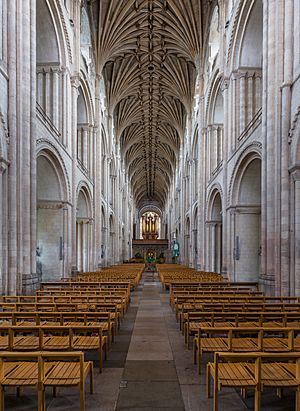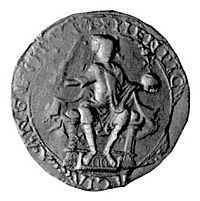Alan fitz Flaad facts for kids
Quick facts for kids
Alan fitz Flaad
|
|
|---|---|
| Born | c. 1078 Probably at Dol-de-Bretagne
|
| Died | Unknown Unknown
|
| Nationality | Breton |
| Occupation | Medieval soldier and landowner Sheriff of Shropshire |
| Years active | c. 1090 – c. 1120 |
| Known for | Progenitor of Stewart Kings of Scotland and FitzAlan Earls of Arundel |
Alan fitz Flaad (born around 1078 – died after 1121) was a Breton knight, a type of soldier for hire. He likely joined the army of Henry I of England during Henry's fights with his brothers. After Henry became King of England, Alan became an important person at court. He received large areas of land in places like Norfolk, Sussex, and Shropshire. This included the castle and lands of Oswestry in Shropshire. Alan was also in charge of watching over the border with Wales. Today, he is known as the ancestor of the FitzAlan family, who became the Earls of Arundel, and the famous House of Stuart, which ruled Scotland for many years.
Contents
How Alan fitz Flaad Became Important
Coming to England
Alan and his father, Flaad, caught the attention of King Henry I of England. Soon after Henry became king, he brought Flaad and Alan to England. Some historians believe Henry met them when he was under attack at Mont-Saint-Michel in 1091. He recruited Breton soldiers at that time. After the attack, he traveled through Brittany, where Alan's family lived. This explains why Henry brought these Breton soldiers, including Alan, to England after the death of the previous king, William Rufus.
We can learn about Alan's time in England by looking at official documents he witnessed. These documents, called charters, were signed by the king during his travels. Alan often witnessed grants of land or money to churches and monasteries.
Working at the Royal Court
Alan was with King Henry I as early as September 1101. He was likely at Windsor Castle, where he witnessed important gifts to Norwich Cathedral. In 1103, he was with the king in Canterbury. There, he witnessed a market being given to the nuns of Malling Abbey and land being bought by Rochester Cathedral.
Later that year, Alan was with the king in the New Forest. They were dealing with matters for Andover Priory, a religious house connected to a large monastery in France called Abbey of Saint-Florent de Saumur. Alan was probably chosen for this meeting because his family had close ties to that French monastery. One of his uncles was even a monk there.
In 1105, Alan went to York. He witnessed the confirmation of a priory (a type of monastery) called Holy Trinity Priory being given to another French monastery. He also witnessed a gift of a church and other items to the Abbey of Ss Sergius and Bacchus in France. This gift was made for the royal family.
In May 1110, Alan was at court in Windsor again. He witnessed the king settling a property dispute between two bishops.
Later, Alan witnessed a royal order to Richard de Belmeis I, who was the Bishop of London and the king's representative in Shropshire. The order was about a dispute over land at Morville Priory. This shows Alan was an important landowner in Shropshire.
Becoming a Powerful Landowner
Alan quickly became very wealthy and powerful. This happened during a time of trouble. A rebellion in 1102, led by Robert de Belleme, had weakened the way the king controlled the Welsh Marches (the borderlands with Wales). King Henry wanted to put loyal supporters in charge. Alan and other Breton friends were given lands that had been taken from rebels in Norfolk and Shropshire.
Alan received even more land as he proved his loyalty. He gained a lot of land in Shropshire and near Arundel in Sussex. These lands had belonged to Rainald de Bailleul, an ancestor of a future king of Scotland. Rainald had received these lands from William the Conqueror for being the High Sheriff of Shropshire. Alan likely received these lands because he was made the Sheriff of Shropshire. He also gained land by marrying Avelina, the daughter of a powerful landowner named Ernulf de Hesdin.
Gifts to Religious Places

Alan was very active in giving money and land to religious institutions. In 1101, he witnessed a gift to Norwich Cathedral concerning the church at Langham, Norfolk. This church "had been Alan's," suggesting he might have given it himself. He also gave the manor (a large estate) of Eaton near Norwich to Norwich Cathedral. The king promised to confirm this gift when Alan came to court. Alan also gave a lot of land to Castle Acre Priory.
However, his most important gifts in Norfolk were to Sporle Priory. This was another Benedictine monastery connected to the French monastery of St Florent de Saumur. Alan founded Sporle Priory. He gave the monks the church at Sporle, its tithes (a portion of income), land, and resources like firewood and pasture for sheep.
Alan also owned Upton Magna in Shropshire, where Haughmond Abbey was later built. Some records suggest his son, William Fitz Alan, founded it around 1100, but this is impossible as William was not born yet. It's possible a small religious community existed there earlier under Alan's protection.
Alan probably made many other smaller gifts. He gave land at his manor of Stretton-on-Dunsmore in Warwickshire to Burton Abbey. He also gave tithes from his lands at Burton on Trent to monks in Brittany. His grandson, Alan fitz Jordan, later confirmed these gifts.
Alan's Family
Alan fitz Flaad married Avelina, who was the daughter of Ernulf de Hesdin. Ernulf was a very important landowner who died during a crusade (a religious war) in Antioch. Some old books mistakenly said Alan's wife was the daughter of another sheriff, but this was proven wrong. Records show that Alan's son, William fitz Alan, referred to his mother as Adelina. Also, a historical writer named Orderic Vitalis mentioned that Ernulf de Heading was the maternal uncle (mother's brother) of William fitz Alan. This means Avelina was Ernulf's daughter.
Alan and Avelina had several children:
- William fitz Alan (died 1160) was the oldest son. King Stephen of England made him High Sheriff of Shropshire in 1137. His son, William, later became known as "Lord of Clun and Oswestry." William is an ancestor of the FitzAlan Earls of Arundel.
- Walter fitz Alan was the second son. He became the first hereditary High Steward of Scotland. He is an ancestor of the Stewart Kings of Scotland, a very famous royal family.
- Jordan fitz Alan, from Burton, inherited lands in Brittany. He also restored a mill to Sele Priory that his father had given.
- Simon fitz Alan, Walter's brother, also went to Scotland. He witnessed his brother's founding document for Paisley Abbey.
After Alan died, Avelina married Robert fitz Walter, who was the Sheriff of Norfolk and Suffolk.
When Did Alan Die?
Historians used to think Alan died around 1114. This was based on a misunderstanding of some old land records. However, later research showed that the land in question belonged to a different family, not Alan's.
We know that Alan's wife, Avelina de Hesdin, was a widow by April or May 1121. At that time, she made a claim for her dower (a portion of her husband's property for her support) related to Eaton manor. King Henry I confirmed this award in Winchester. So, Alan must have died before this time, but possibly only a few months earlier.
Alan's Family Tree
This family tree shows how Alan fitz Flaad connects to important families.
| Family of Alan fitz Flaad | |||||||||||||||||||||||||||||||||||||||||||||||||||||||||||||||||||||||||||||||||||||||||||||||||||||||||||||||||||||||||||||||||||||||||||||||||||||||||||||||||||||||||||||||||||||||||||||||||||||||||||||||||||||||||||||
|---|---|---|---|---|---|---|---|---|---|---|---|---|---|---|---|---|---|---|---|---|---|---|---|---|---|---|---|---|---|---|---|---|---|---|---|---|---|---|---|---|---|---|---|---|---|---|---|---|---|---|---|---|---|---|---|---|---|---|---|---|---|---|---|---|---|---|---|---|---|---|---|---|---|---|---|---|---|---|---|---|---|---|---|---|---|---|---|---|---|---|---|---|---|---|---|---|---|---|---|---|---|---|---|---|---|---|---|---|---|---|---|---|---|---|---|---|---|---|---|---|---|---|---|---|---|---|---|---|---|---|---|---|---|---|---|---|---|---|---|---|---|---|---|---|---|---|---|---|---|---|---|---|---|---|---|---|---|---|---|---|---|---|---|---|---|---|---|---|---|---|---|---|---|---|---|---|---|---|---|---|---|---|---|---|---|---|---|---|---|---|---|---|---|---|---|---|---|---|---|---|---|---|---|---|---|---|---|---|---|---|---|---|---|---|---|---|---|---|---|---|---|
|
|||||||||||||||||||||||||||||||||||||||||||||||||||||||||||||||||||||||||||||||||||||||||||||||||||||||||||||||||||||||||||||||||||||||||||||||||||||||||||||||||||||||||||||||||||||||||||||||||||||||||||||||||||||||||||||




